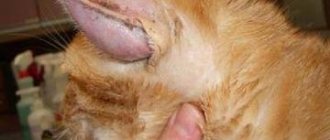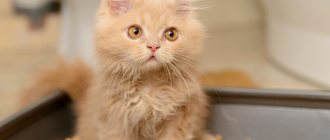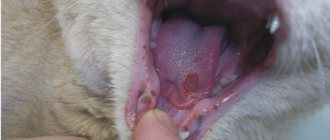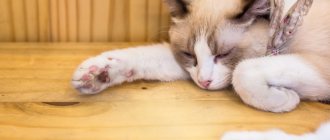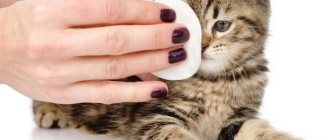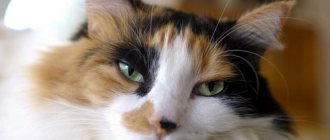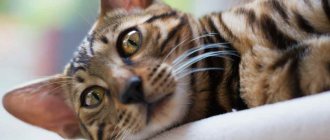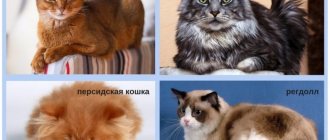What is a heart attack
The term “heart attack” itself is not entirely correct, since it does not describe any specific disease, but only its consequence. Specifically in this case we are talking about the consequences of myocardial infarction, i.e. about the necrosis and death of part of the muscle tissue of the heart itself.
Since the heart is a muscular organ in itself, any disturbances in its structure disrupt the normal rhythm of work, have a bad effect on the heart rate and lead to other serious consequences.
Interestingly, it is not even the heart attack itself that is dangerous (although the animal may well die because of it). At this moment, the entire body may experience acute hypoxia (severe lack of oxygen), which in the foreseeable future leads to the development of kidney pathologies. In addition, in some cases even the cerebral cortex is affected, which also does not go away without a trace.
Causes of a heart attack in a cat
To put it bluntly, the causes of a heart attack can be difficult to identify. An attack can be caused by diseases of the cardiovascular system, poisoning, parasites (heartworm, for example), other factors, even severe stress. But still, some predisposing factors need to be considered separately:
- Kidney diseases. This is due to the fact that the adrenal glands secrete hormones that help the body regulate blood pressure. After serious illnesses, the adrenal glands can “go crazy”, the release of hormones increases or decreases sharply, and blood pressure jumps. This has a very bad effect on the heart.
- Heartworm (a disease called dirofilariasis). Adults “nest” in the pulmonary vessels and coronary arteries, abundantly saturating the blood with toxins. If there are a lot of parasites, their secretions may well be enough to cause the death of some part of the myocardium.
- Age. By old age, the heart has already had time to largely exhaust its resource, and therefore the risk of attacks and cardiac pathologies increases significantly.
- Improper and unbalanced diet with excess fat and protein.
- Excess weight . This factor is especially dangerous for neutered cats.
- Pathologies of the endocrine glands.
- Infectious diseases , especially viral etiology.
- Any diseases and pathological conditions accompanied by an acceleration of ESR and an increase in blood viscosity. In these cases, the blood can become so viscous that it does not flow well through small blood vessels and does not properly nourish the heart itself. In such cases, by the way, a stroke is more likely.
A few words about prevention
What can you do to ensure that your pet never finds out about this disease? Firstly, it all depends on you. When you choose a kitten, try to thoroughly study the pedigree of its ancestors: if there were cases of heart pathologies in it, it would be better to refrain from such a purchase. Keep in mind that sedentary lifestyle and obesity are not just human enemies. Walk your cat and watch his diet. His diet must be as balanced as possible, since otherwise an excess of nutrients will sooner or later lead to the same obesity, with all the consequences... Finally, in adult cats, like in humans, heart problems very often worsen after general anesthesia . Therefore, before any operation that involves it, the animal must undergo a good examination. By the way, is heart failure in cats generally treatable?
Symptoms and first signs of a heart attack in a cat
The owner should pay attention to the following symptoms and early signs of a heart attack in a cat:
- From the moment of the attack, the heart works very poorly, the body does not receive the required amount of oxygen. This is why all visible mucous membranes of the cat turn blue.
- You may notice shortness of breath or other respiratory rhythm disturbances. If a cat begins to get nervous and run around during an attack, then due to severe shortness of breath and hypoxia developing against this background, it may simply faint.
- If the attack is severe and the heart is working very poorly, hypoxia develops so severe that the animal may show signs of confusion (inappropriate behavior). This is due to oxygen starvation of the brain.
- There are strong “jumps” in body temperature. It can either suddenly rise above normal, or just as suddenly fall. Because of this, the cat sits at the very beginning of the attack, trembling violently.
- The animal develops a strange “wooden” gait, or the cat begins to move in some other way.
- In very rare cases, palpation of the chest at the level of the left elbow joint can reveal severe pain.
- Characterized by catastrophic disturbances of the heart rhythm, causing the pulse to be severely disturbed.
It is possible to speak with confidence about the presence of any pathologies of the cardiovascular system in an animal only after an ECG has been performed.
General information
Congestive heart failure is a broad medical term that means that a cat's heart cannot deliver enough blood to all organs and tissues.
When the heart is unable to pump enough blood, the body can usually compensate to ensure tissues receive blood and oxygen to function. However, when cardiac pathology worsens, these compensation mechanisms become ineffective. The heart is then unable to pump enough blood to the body and fluid accumulates in the veins of the lungs. This condition can lead to pulmonary edema, hence the term congestive heart failure.
Although many conditions can lead to congestive heart failure in cats, one of the most common causes is hypertrophic cardiomyopathy. In this pathological condition, the muscular walls of the heart become so thick that they are unable to stretch and fill with enough blood to pump effectively. As a result, fluid will accumulate in the lung tissues, making breathing difficult. Fluid may also leak into the abdomen, but this is less common in cats than in dogs with similar heart conditions. Cats often leak fluid into the chest cavity.
Other causes of congestive heart failure in cats include:
- Hyperthyroidism
- High blood pressure
- Heart valve insufficiency or stenosis
- Defects in the walls of the heart
- Pathological shunts (patent ductus arteriosus)
- Fluid accumulation in the pericardium
- Blood clots in the chambers of the heart
- Heart rhythm disturbances
- Inflammation of the heart muscle
- Tumors
- Anemia (low number of red blood cells)
- Pregnancy
- Stress
Congestive heart failure can occur at any age, in any breed, and in cats of any gender, but it is most common in older older cats.
First aid for a cat at home
Let’s immediately decide on one point: if the pet is already lying down with an attack, then the only effective first aid is to immediately call a veterinarian.
It is hardly possible to do anything else at home (in particular, pouring medicine into the mouth is no longer useful). Therefore, it is necessary to “catch” the first warning signs of an attack, since at this time it is still possible to at least somehow help the animal:
- 3 drops of cardamine. Also, some veterinarians advise giving the cat up to 11 drops of Corvalol. If everything is done on time, then the attack will almost certainly be extinguished or, at least, significantly alleviated.
- The cat is shown absolute peace. If an animal feels bad, there is no need to run around it, put it in a basket and go to the clinic. This can only worsen the pet’s condition, speed up and worsen the attack of acute heart failure in the cat.
- The cat must be placed in a cool, well-ventilated room. The hotter and stuffier the room, the more severe the heart attack. A fact known to many doctors. Of course, this does not mean that the cat should be thrown out onto the balcony or placed directly under the air conditioner, but it is worth opening the window slightly or turning on the fan.
What is heart failure: types and typology
Heart failure in cats is not just heart disease, but various heart disorders. That is, this is a series of deviations that disrupt muscle function
, lead to its inability to contract properly, and therefore to poor circulation in the animal’s body.
This is a dangerous and scary condition
, because the cat is literally balancing between life and death. Indeed, in a normal and calm state, the heart is able to provide the body with the necessary elements, but as soon as the pet actively moves, runs, jumps, or even just gets very scared and nervous, signs of asphyxia appear.
It is worth noting that in pets, unlike in humans, such heart problems are quite rare. If they develop, it is mainly from the age of 6 years. However, there are exceptions that are associated with the birth of a kitten. During pregnancy, he might not have enough minerals and vitamins, so the diagnosis of heart failure is made already at the age of six months or earlier. Then the kitten is doomed to a quiet life without activity and movement, unless certain measures are taken.
Heart failure in cats: types
If we talk about the types of heart failure, then there are only two of them: acute and chronic heart failure . Everything is the same as with people:
- Chronic, as you might guess, develops slowly, often its symptoms are not visible at all for a long time, but the disease is stable.
- Acute heart failure is characterized by rapidity, appearing from time to time in the form of attacks that last from several minutes to several hours. The attacks are accompanied by pulmonary edema, during which there is bleeding from the nose or even the mouth. Shortness of breath is also common.
Heart failure in cats: typology
- The typology of the disease, heart failure in cats, is even broader:
- A failure called systolic myocardial . This is a weakening of the myocardium and the number of contractions in general. It is mainly detected using echocardiography , during which the veterinarian observes the rhythm of wall movement and contraction of the ventricles of the heart. Here the cause can also be a severe bruise or injury. There are often cases when pathology develops due to poisoning, long-term use of medications, low-quality medications, heat stroke, electric shock, as well as oncology of any kind.
- Pathology due to low blood flow in the veins , pressure on the heart by fluid in the heart sac. The disease develops due to diastolic dysfunction, due to the tightening of the gastric walls.
- Increased blood pressure due to frequent and constant stress on the heart and body in the form of heavy physical exercise.
- The ventricles can become overfilled with blood , causing congestion in the heart and failure to develop faster. This can also happen due to certain diseases.
Treatment regimen for a cat after a heart attack
Any treatment regimen for a cat after a heart attack involves creating the most comfortable and calm conditions for the pet. In particular, for the first two weeks from the moment of the attack, you should not play with the cat, you cannot let it go outside, you cannot move, have a party at home, or do repairs. Lack of stress is a sure guarantee of an animal’s recovery! In addition, the following conditions must be met:
- The animal is given unlimited access to clean drinking water, which it must have at all times, regardless of the time of day.
- It is very advisable to prepare a high-quality, balanced diet for your pet, or immediately use special veterinary holistic treatments for animals with heart pathologies.
- Diuretics are prescribed to prevent edema (and in case of heart pathologies they will almost certainly occur).
- ACE inhibitors are required. They normalize the condition of the vascular system.
- Cardiotonics that improve heart contractility are urgently needed.
During the first three months, your pet should be taken to the veterinarian at least twice a month. The specialist needs to assess the dynamics of recovery and, if necessary, adjust the prescribed treatment. And even after this, a cat that has suffered an attack is shown to the veterinarian at least once a quarter.
Heart failure in a cat. Heart failure in cats
Thanks Andrey.
We live in Canada. The doctor who made the diagnosis (cardiologist) said that transplant operations in the USA/Canada are experimental and are not performed on pets. The mortality rate of such operations is 80%; the remaining 20% are euthanized after some time to look at the results of the experiment. Perhaps they are being made somewhere else, which is what we are trying to find out.
Symptoms: the cat became extremely inactive and lost a lot of weight. For some time (in retrospect) the cat lost activity, but we believed that this was influenced by other factors, not his health. Then there was a sharp deterioration within a week.
Heart medications for cats
The following heart medications for cats can be used in veterinary practice:
- Diuretics include cheap and effective furosemide and diacarb.
- Enalapril, Ramipril, Benazepril are used as ACE inhibitors in veterinary medicine.
- Adrenaline can be used to stimulate cardiac activity in the first hours after an attack; subsequently, caffeine-sodium benzoate is used (it is much safer and “softer”).
- Pimobendan is prescribed as a cardiotonic.
Prevention measures
Experienced breeders try to observe the following preventive measures:
- The animal's diet must be balanced. For old and castrated/sterilized pets, food is selected separately.
- The cat must be regularly, promptly vaccinated and treated against parasites.
- It is necessary to lock household chemicals, medications, and other potentially toxic compounds in places inaccessible to animals.
- Contact your veterinarian promptly if you notice strange behavior or other alarming symptoms.


